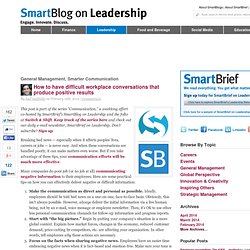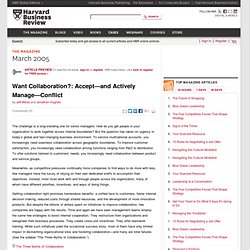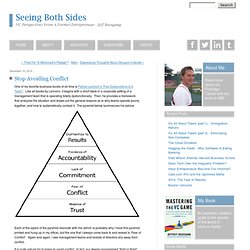

How to have difficult conversations that produce positive results SmartBlogs. This post is part of the series “Communication,” a weeklong effort co-hosted by SmartBrief’s SmartBlog on Leadership and the folks at Switch & Shift.

Keep track of the series here and check out our daily e-mail newsletter, SmartBrief on Leadership. Don’t subscribe? Sign up. Breaking bad news — especially when it affects peoples’ lives, careers or jobs — is never easy. And when these conversations are handled poorly, it can make matters even worse. Many companies do poor job (or no job at all) communicating negative information to their employees. Make the communication as direct and personal as possible. Joel Garfinkle is recognized as one of the top 50 coaches in the U.S., having worked with many of the world’s leading companies, including Oracle, Google, Amazon, Deloitte, The Ritz-Carlton, Gap and Starbucks. Want Collaboration?: Accept—and Actively Manage—Conflict. The challenge is a long-standing one for senior managers: How do you get people in your organization to work together across internal boundaries?

But the question has taken on urgency in today’s global and fast-changing business environment. To service multinational accounts, you increasingly need seamless collaboration across geographic boundaries. To improve customer satisfaction, you increasingly need collaboration among functions ranging from R&D to distribution. To offer solutions tailored to customers’ needs, you increasingly need collaboration between product and service groups. Meanwhile, as competitive pressures continually force companies to find ways to do more with less, few managers have the luxury of relying on their own dedicated staffs to accomplish their objectives. So what’s the problem? This can come as a surprise to even the most experienced executives, who generally don’t fully appreciate the inevitability of conflict in complex organizations. Conflict Management: Style and Strategy. Conflict Management--Style and Strategy In a Nutshell It's important to remember that there are many strategies we can use in conflict situations, but each of us tends to habitually use some strategies more often than others.

To most effectively resolve a conflict, we should use the strategy that is most appropriate for that particular conflict situation. However, that strategy might not be the strategy that we habitually use. The Wrong Strategy for Shaun Williams How often do we make the mistake that Shaun Williams (celebrating in the photo above) made on Sunday; i.e., responding to a conflict situation the way we feel like responding rather than the way we should respond? The incident occurred at the end of a very close game--a time when his team could not afford any penalties. Conflict Management Strategies There is a menu of strategies we can choose from when in conflict situations:
Conflict Resolution - Resolving conflict rationally and effectively - Leadership training from MindTools. Conflict is an inevitable part of work.

We've all seen situations where people with different goals and needs have clashed, and we've all witnessed the often intense personal animosity that can result. As you'll learn in this article and video, the fact that conflict exists, however, is not necessarily a bad thing. When you resolve it effectively, you can also eliminate many of the hidden problems that it brought to the surface. Institute of Conflict Management. Basics of Conflict Management. Conflict Management Skills. Gregorio Billikopf Party-Directed Mediation (3rd Edition - January 2014) 446 pages + xvi preface 14 chapters, 3 appendices, index Author: Gregorio Billikopf, University of California Public Service of the University of California Printing, copying or distribution of the on-line version of Party-Directed Mediation is permitted for personal, non-commercial use as long as the author and the University of California are credited, including copyright notices.

Stop Avoiding Conflict. One of my favorite business books of all time is Patrick Lencioni’s “Five Dysfunctions of a Team”.

Like all books by Lencioni, it begins with a short fable in a corporate setting of a management team that is operating totally dysfunctionally. Then, he provides a framework that analyzes the situation and draws out the general lessons as to why teams operate poorly together, and how to systematically combat it. The pyramid below summarizes his advice. 7 Simple Steps to Resolve Any Problem. Struggles and difficulties are part of life.

You cannot avoid these problems; it will always arise no matter how much you try to take control or organize the things in your life. Most people spend more time and energy going around problems than in trying to solve them. ~ Henry Ford Problems are not the reason why a person lives a difficult and miserable life; most of the time, it’s a matter of perspective. Because often, majority of people let problems defeat them through feelings of anger, fear and anxiety. These negative feelings paralyze a person to move forward and take a step in resolving the problem. On the other hand, perspective is also the reason why there are people who succeed despite struggles and difficulties in life. If you get easily paralyzed and depressed by the problems in your life, take time to read and follow these seven steps in resolving problem.
Don’t dwell on what went wrong. 1. Stop feeling angry, scared and anxious even for just a few minutes. Managing Conflict at Work - a guide for line managers.pdf (application/pdf Object)